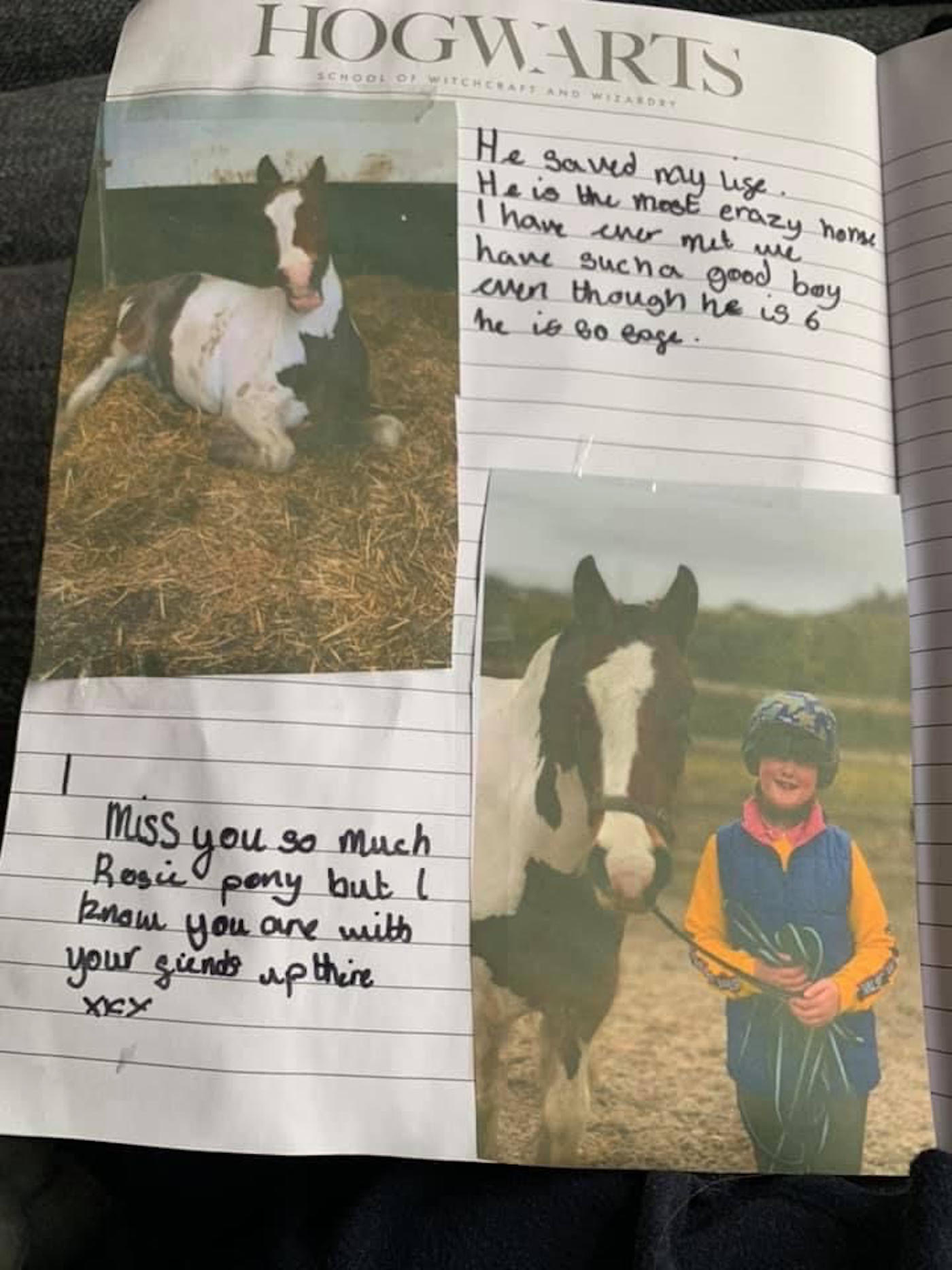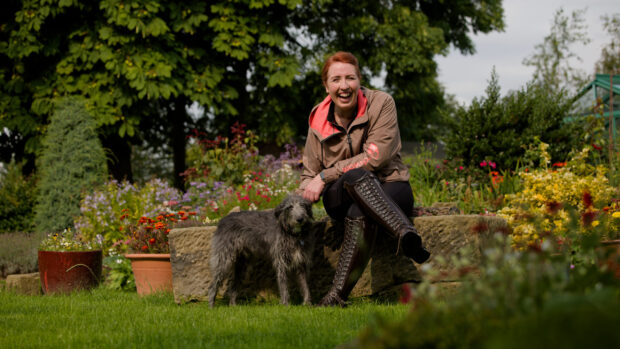The owner of one of 16 horses who died at the same livery yard within a week hopes that by telling their story, she might be able to prevent others’ suffering.
Eliza Simpson’s pony Rosie was seven when she had to be put down, in October 2020, and Eliza was eight. Her mother Michaela is one of nine owners with whom the yard owner has now settled out of court, without admitting liability, in a legal case.
H&H reported at the time that the deaths were thought to have been caused by a mystery toxin. The horses’ owners case is that the cause was ingestion of bacterium clostridiuom botulinum via their haylage, made on the farm they lived at by the farm’s owner. This was not accepted by the yard owner, who disputed that botulism was the cause of the deaths, and that he was liable.
Michaela told H&H she is glad she can now talk about what happened.
“Rosie and Eliza were best friends,” she said. “We’d spent three months getting Rosie to trust people, but then she would follow Eliza round; it was a beautiful relationship.”
Michaela said that on 12 October, the first horse, Gus, was ill, with nasal discharge and unsteady on his feet. The yard was locked down in case it was strangles, but the next day Gus had to be put down.
“The next day, we had a call from someone at the yard saying Rosie kept dropping to her knees,” Michaela said. “I was told it was colic and dashed down there but when I got to her, half an hour after she’d been spotted, she wasn’t Rosie any more.”
Michaela said Rosie was stiff, could not walk properly, did not want food and appeared distressed.
“In the 10 months we’d had Rosie, we’d never seen her lying down but as soon as she got into the stable, she just slumped, and put her head on me and couldn’t do anything,’ she said. “And by that point, another two horses had been spotted showing the same symptoms.”
Vets attended, and Rosie was given an anti-inflammatory injection as she was spasming, Michaela said. She was also shivering but hot to touch, but managed to walk into the lorry and was taken to hospital with Fonzie, an Arab yearling. Another horse, Millie, was also taken in and by that evening, Cassie, Harley and another horse were showing similar signs and had been taken to hospital.
“The vet rang me about 8pm; we were all sitting around in the yard as we didn’t know where else to be,” Michaela said. “The vet said it might be a microtoxin or soil contamination of the haylage, and that if it was botulism, there was no anti-toxin for it in this country, because according to the experts it doesn’t exist here. She said if it’s either of those, her chances of survival are about 10%, and if she does survive, she won’t be Rosie any more, she’ll be a shadow of herself. At that point, I knew we might not see her again.
“I got home about 11pm and the first thing Eliza said was ‘Mummy, I didn’t get to say goodbye to her’. She just knew. My husband went outside as he was in bits and she said ‘Rosie’s gone and I never got to say it’.”
After a sleepless night, Michaela spoke to the vets first thing the next day.
“There wasn’t a decision to make; it wasn’t ethical to keep her alive,” she said. “She’d lasted 15 hours since she’d fallen ill.”
Milly, Legs and Fonzie were also put down that day. By 20 October, Clover, Caballo, Pino, Princess, Tinker, Bella, Cassie, Harley and one other horse had either died or been put down. The yard owner’s pony and donkey Andy and Derek were also put down. All the affected horses had eaten the same haylage.
“We slept at the yard the whole week,” Michaela said. “They were almost making pellets of their hay in their mouths as if their nervous systems were shutting down. That’s what botulism does, and we basically sat around waiting for the horses to start showing symptoms. There was another pony who’d been a confidence giver for Eliza — she lasted till the Sunday.”
Michaela said she now wants to “get the facts out there”.
‘But it’s been so emotive for all of us,” she said. “About half the owners haven’t got back into riding as it’s too raw, too upsetting. For the little ones it was more important, as it’s their life.”
The only pony who was taken ill but survived was Minstrel, who was in hospital until 12 December.
“He’s as feisty as ever but he’ll never be the same,” Michaela said. “He can’t be jumped or competed because it’s almost like he’s had a stroke.
“And some people have been left with bills of tens of thousands. The yard owner and manager have never apologised, or admitted liability; they’re adamant it was nothing to do with them. But now we’re able to say what happened, which is very important as I don’t want this happening to anyone else, because it was horrific. No human or animal should have to go through what they did.”

Michaela said Eliza was offered a loan pony, who “in Eliza’s own words”, has saved her.
“But he’s saved all of us,” she said.
“Eliza wrote a story for school, and came home with a book she’d made, it was heartbreaking but it really helped her,” she said.
“That week was horrific. We’ve all had animals pass away but it was just like watching your whole world fall apart. But we’ve got to tell people what happened.”
Michaela, who said her settlement was less than two thirds of her uninsured losses, and has not been able to afford to buy another horse, says all the owners are still out of pocket.
She added that she would like to see the anti-toxin for botulism available in the UK should any horse need it in future.
“It’s been a tough 15 months,” she said.
H&H approached the yard owner for comment but none had been received by the time of publication.
Feeding haylage
Equine nutrition expert Clare McLeod said: “It is crucial that haylage is kept airtight since this is key to avoid spoilage. Unlike silage, the grass in haylage is not preserved solely due to bacterial fermentation and the resulting acidity but depends on being airtight for its preservation. If air gets into a bale of haylage, the result will be heating of the forage from the growth of moulds and bacteria, which may be pathogenic (disease-causing).”
Eight layers of plastic wrap or more are recommended to ensure that haylage bales are not punctured – letting in air and therefore causing spoilage – during handling, transportation and storage. Some producers use up to 20 layers, especially on drier forages with stiffer stems.
Botulism is the term used to describe disease caused by the neurotoxin produced by clostridium botulinum bacteria. A very small amount of the toxin is fatal to horses.There is a risk of C botulinum poisoning in fermented wrapped forages, and big-bale hay, if the quality of either is poor. In well-preserved silage or haylage botulism is highly unlikely as the pH is too low (silage) and the water activity too low (haylage).
Botulism outbreaks in horses have been reported from feeding big-bale silage and haylage, and also hay and other feeds – but in most cases where the feed or forage was identified as a source of the neurotoxin, there was spoilage, carcass or soil contamination. Typically botulism from forage occurs from contamination with soil, animal carcasses or poultry slurry, or from rotting owing to poor quality wrapped forages not being preserved thoroughly, or hay not being stored correctly.
Good practice includes:
Careful harvesting techniques to reduce the risk of contamination of the bales with soil, including grass cutting at 10cm or higher, taking care over raking, and not harvesting when the ground is wet and muddy.
Cutting the crop across the field to allow small mammals more chance to escape, thus reducing the risk of animal carcasses in the finished forage.
Wilting the forage for 36 to 48 hours before wrapping to ensure enough dry matter (low dry matter and high pH are a risk).
Not using poultry slurry on pasture destined for haylage production, and avoiding harvesting after the application of any slurry.
Wrapping with sufficient layers of plastic to ensure an airtight seal.
Handling, storing and transporting with care to avoid puncture, and disposal of any punctured bales.
Prompt removal and replacement of any bales showing any spoilage immediately on opening, including moulding, unusual smell or any rotten areas.
You might also be interested in:

Multiple horse deaths at livery yard linked to unknown toxin
An equine hospital has confirmed a “significant” number of horse deaths at a livery yard since 13 October

Desperate appeal for help after nine horses’ mystery deaths
The horses have all seemed in good health, but died within minutes

Subscribe to Horse & Hound magazine today – and enjoy unlimited website access all year round
Horse & Hound magazine, out every Thursday, is packed with all the latest news and reports, as well as interviews, specials, nostalgia, vet and training advice. Find how you can enjoy the magazine delivered to your door every week, plus options to upgrade your subscription to access our online service that brings you breaking news and reports as well as other benefits.





